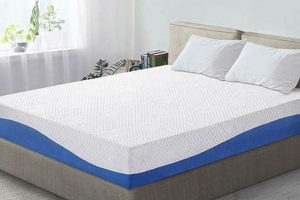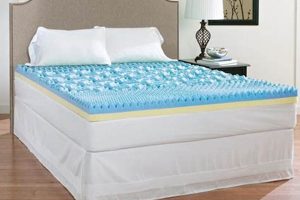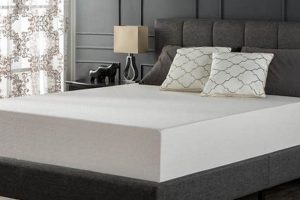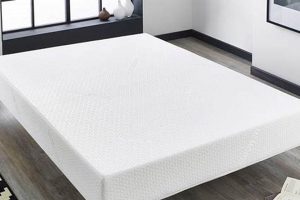A supportive base designed to enhance the lifespan and comfort of viscoelastic polyurethane foam sleeping surfaces. These bases are essential for ensuring proper weight distribution, preventing sagging, and maintaining the integrity of the mattress. Examples include platform beds, slatted frames, and adjustable power bases.
The appropriate support structure significantly impacts sleep quality by optimizing the mattress’s ability to conform to the body. It also contributes to the longevity of the sleeping surface, protecting it from premature wear and tear. Historically, less specialized bed frames were commonplace; however, the advent of memory foam necessitates a more tailored approach to ensure optimal performance and prevent voiding warranties.
The selection of a compatible understructure depends on various factors, including desired height, budget, and lifestyle preferences. The following sections will delve into different types of support systems, their relative advantages and disadvantages, and key considerations for making an informed decision.
Tips for Selecting a Suitable Base
Choosing the right understructure is vital to maximizing the performance and longevity of memory foam sleeping surfaces. Consider the following guidelines to ensure compatibility and optimal support.
Tip 1: Understand Warranty Requirements: Many manufacturers stipulate specific support requirements to maintain the validity of the mattress warranty. Review the warranty details carefully to avoid potential issues.
Tip 2: Assess Support Structure: A solid, flat surface offers the most consistent support. Slatted foundations should have slats spaced no more than a few inches apart to prevent sagging.
Tip 3: Consider Bed Height Preferences: Account for the thickness of the mattress when selecting a base to achieve the desired overall bed height. This is especially important for individuals with mobility limitations.
Tip 4: Evaluate Weight Capacity: Confirm that the support structure’s weight capacity is sufficient to accommodate the mattress and all sleepers. Exceeding the weight limit can lead to premature wear and potential structural failure.
Tip 5: Explore Adjustable Bases: If adjustability is desired, ensure compatibility with the memory foam mattress. Some mattresses may not be suitable for use with adjustable power bases.
Tip 6: Prioritize Breathability: Memory foam can retain heat, so choose a base that promotes airflow. Slat foundations generally offer better breathability compared to solid platforms.
Selecting the appropriate support structure ensures proper alignment, prolongs the lifespan of the mattress, and contributes to a comfortable and supportive sleep experience. These considerations are crucial for realizing the full benefits of a memory foam mattress.
Having addressed these key aspects, the subsequent sections will explore specific types of support structures in greater detail, further aiding the decision-making process.
1. Support
The concept of “support” is paramount when evaluating the suitability of a base for a memory foam mattress. The effectiveness of the mattress in providing pressure relief and spinal alignment hinges on the underlying support structure. Insufficient or inadequate support negates the benefits of the foam and potentially shortens the mattress’s lifespan.
- Weight Distribution
The primary function of support is to evenly distribute the weight of the mattress and occupants. A foundation that fails to provide uniform support can lead to localized sagging, particularly in areas of concentrated pressure. This unevenness compromises the mattress’s ability to contour to the body, resulting in discomfort and potential musculoskeletal strain. For example, a slatted foundation with excessively wide gaps may cause the foam to sink between the slats, creating pressure points.
- Prevention of Sagging
Memory foam is susceptible to sagging over time, especially without adequate support. A robust foundation prevents the development of indentations and maintains the mattress’s original shape. A solid platform or closely spaced slats provide a stable surface that minimizes stress on the foam layers. Conversely, a weak or poorly constructed base may accelerate sagging and reduce the overall lifespan of the mattress.
- Enhancement of Conformity
Proper support enhances the mattress’s ability to conform to the body’s contours. The foundation should allow the foam to react effectively to pressure points, providing targeted support where needed. This promotes proper spinal alignment and reduces pressure on sensitive areas, such as the hips and shoulders. A rigid or unyielding base can hinder the mattress’s ability to conform, diminishing its pressure-relieving properties.
- Adherence to Warranty Requirements
Most memory foam mattress warranties stipulate specific support requirements. Using an unapproved or inadequate foundation can void the warranty, leaving the consumer without recourse in the event of premature mattress failure. It is imperative to consult the warranty documentation and select a base that meets the manufacturer’s specifications regarding support type, slat spacing, and weight capacity.
These facets underscore the critical role of support in maximizing the benefits and longevity of memory foam mattresses. Selecting a foundation that addresses these considerations is essential for ensuring a comfortable and supportive sleep environment and safeguarding the investment in the mattress itself. The interplay between support and other key factors, such as airflow and adjustability, further informs the decision-making process.
2. Durability
Durability constitutes a critical attribute in the context of bases for memory foam mattresses. The longevity and sustained performance of the sleeping surface are intrinsically linked to the structural integrity and resilience of its supporting foundation. A durable base ensures consistent support, preventing premature wear and tear and maximizing the value of the mattress investment.
- Material Composition and Construction
The selection of materials and the methods employed in construction directly influence the base’s durability. Solid wood frames, steel platforms, and reinforced slat systems offer superior resistance to bending, warping, and breakage compared to less robust alternatives. For example, a platform bed constructed from kiln-dried hardwood is inherently more durable than one assembled from particleboard or softwood. Similarly, a steel frame with welded joints provides greater stability and longevity than a frame with bolted connections.
- Weight Capacity and Load-Bearing Capability
A durable base must possess adequate weight capacity to accommodate the combined weight of the mattress and its occupants. Exceeding the base’s weight limit can lead to structural failure, resulting in sagging, uneven support, and premature deterioration. Manufacturers typically specify weight limits; adherence to these guidelines is crucial for ensuring long-term durability. For instance, a reinforced metal frame designed to support up to 1000 pounds is suitable for heavier individuals or couples, while a lighter-duty frame may be adequate for a single sleeper.
- Resistance to Wear and Tear
A durable base should exhibit resistance to common forms of wear and tear, such as scratching, denting, and corrosion. Protective finishes, such as powder coating on metal frames or varnish on wooden frames, enhance resistance to these environmental factors. The choice of materials that are naturally resistant to pests and moisture further contributes to long-term durability. A well-maintained base, shielded from excessive humidity and physical damage, will retain its structural integrity for an extended period.
- Longevity and Lifespan Expectancy
The expected lifespan of a foundation is a significant factor in determining its overall value. A durable base, constructed from high-quality materials and engineered for robust performance, can provide reliable support for many years. Investing in a long-lasting foundation reduces the need for frequent replacements, ultimately saving money and minimizing environmental impact. The lifespan expectancy of a base should align with the expected lifespan of the memory foam mattress itself, ensuring a cohesive and enduring sleep system.
In summation, the durability of a base is an indispensable consideration when selecting the ideal support system for a memory foam mattress. By prioritizing materials, construction methods, weight capacity, and resistance to wear and tear, consumers can ensure a durable foundation that maximizes the lifespan and performance of their sleeping surface. This focus on longevity translates to enhanced value, sustained comfort, and a reduced risk of premature failure, solidifying the importance of durability in the context of the “best foundation for memory foam mattress.”
3. Airflow
Airflow is a crucial consideration when selecting a support structure for memory foam mattresses. Due to the inherent density of memory foam, heat retention can be a concern, potentially leading to discomfort during sleep. The foundation plays a significant role in mitigating this issue by promoting ventilation and dissipating heat.
- Slat Design and Spacing
Foundations with slats, as opposed to solid platforms, inherently offer greater airflow. The spacing between slats directly influences the degree of ventilation. Wider gaps facilitate more effective air circulation, allowing heat to escape from the underside of the mattress. For example, a foundation with slats spaced 2-3 inches apart provides substantially better airflow compared to a platform with minimal or no gaps. Conversely, excessively wide spacing may compromise support and potentially void the warranty.
- Material Permeability
The materials composing the foundation impact its ability to promote airflow. Natural materials like wood are generally more breathable than synthetic materials like plastic or metal. However, the design can offset this. For example, a wooden frame with a solid fabric covering will restrict airflow more than a metal frame with open slats. The permeability of any fabric or covering on the foundation should be considered in relation to its effect on ventilation.
- Foundation Height and Clearance
The height of the foundation and the clearance beneath it can influence airflow. A taller foundation provides more space for air to circulate around the mattress, while adequate clearance underneath allows for ventilation from below. A low-profile foundation with minimal clearance may restrict airflow, exacerbating heat retention issues. Raising the bed frame or using bed risers can improve airflow in such cases.
- Impact on Mattress Performance
Adequate airflow contributes to the overall performance and longevity of the memory foam mattress. By dissipating heat and reducing moisture buildup, it helps prevent the breakdown of the foam and inhibits the growth of mold and mildew. This, in turn, extends the lifespan of the mattress and maintains its comfort and support characteristics. In contrast, poor airflow can lead to premature degradation of the foam and a less comfortable sleep environment.
The selection of a foundation that prioritizes airflow is essential for maximizing the comfort and lifespan of memory foam mattresses, particularly for individuals who tend to sleep hot. Balancing the need for support with the benefits of ventilation is key to choosing the best possible understructure.
4. Height
The height of a bed foundation significantly influences accessibility, aesthetics, and storage capacity, factors directly impacting the overall suitability of a supporting structure for a memory foam mattress. The combined height of the foundation and mattress determines the ease with which an individual can enter and exit the bed, a consideration particularly relevant for individuals with mobility limitations. Moreover, bed height contributes to the visual proportions of a room, affecting its aesthetic harmony. Increased foundation height can also provide valuable under-bed storage space, particularly advantageous in smaller living areas. For example, a platform bed with a 14-inch clearance offers ample room for storing bins or other items, while a low-profile foundation provides minimal or no such utility.
The desired height often depends on individual preferences and practical needs. Taller individuals may prefer a higher bed for ergonomic reasons, minimizing strain on their knees and back. Conversely, shorter individuals or those with mobility issues might opt for a lower bed for easier access. The overall style of the room also influences the ideal bed height. A modern, minimalist aesthetic often favors low-profile designs, while a more traditional or luxurious style might incorporate a taller bed. Furthermore, certain bedroom configurations, such as those with low ceilings, may necessitate a lower bed to maintain a sense of spaciousness. The thickness of the memory foam mattress itself must be factored into the decision-making process to achieve the desired final bed height.
In summary, the consideration of height is a crucial aspect of selecting a compatible foundation for a memory foam mattress. Height influences accessibility, aesthetics, and storage, directly impacting user satisfaction. The optimal height is subjective, depending on individual needs, preferences, and the overall design of the bedroom. Balancing these factors ensures the selection of a foundation that not only supports the mattress effectively but also complements the user’s lifestyle and enhances the functionality of the sleeping space.
5. Warranty
The interplay between mattress warranties and the choice of a foundation is significant. Most memory foam m
attress manufacturers stipulate specific requirements for the supporting structure to maintain warranty validity. These stipulations often relate to the type of foundation, slat spacing, and load-bearing capacity. Using a foundation that does not meet these specifications may void the warranty, leaving the consumer without recourse in the event of mattress defects or premature failure. This represents a direct cause-and-effect relationship: an incompatible foundation leads to warranty invalidation, and potentially, financial loss.
Understanding and adhering to warranty requirements is a crucial component of selecting the most suitable base. For example, a slatted foundation with wide gaps might not provide sufficient support for a memory foam mattress, leading to sagging. If the mattress warranty specifies a maximum slat spacing of 2 inches, using a foundation with 4-inch spacing would likely invalidate the warranty. In this scenario, the consumer bears the cost of repairing or replacing a defective mattress, despite its seemingly premature failure. Prioritizing compliance with warranty stipulations, therefore, prevents potential financial burdens and ensures access to manufacturer support if needed.
In conclusion, the warranty serves as a critical guide in the selection process. It dictates acceptable foundation types and dimensions, safeguarding the consumer’s investment and ensuring access to support in case of product defects. Neglecting to consider the warranty specifications introduces financial risk and undermines the long-term value of the memory foam mattress. Adhering to warranty guidelines is a key element in achieving the best and most reliable support for a memory foam mattress.
6. Adjustability
Adjustability, in the context of foundations, refers to the capability of the support structure to be modified or repositioned to suit specific needs or preferences. For memory foam mattresses, this most commonly manifests in adjustable power bases, which allow the user to elevate the head and/or foot of the bed. The connection between adjustability and suitability as a base for memory foam is primarily driven by the desire for enhanced comfort and ergonomic support.
Adjustable bases offer several potential benefits. Elevation of the upper body can alleviate symptoms of acid reflux or sleep apnea, while raising the legs can improve circulation. These features are particularly relevant for individuals with certain medical conditions or those seeking enhanced relaxation. The compatibility of the mattress with the adjustable base is paramount. Memory foam mattresses, due to their flexibility, are generally well-suited for adjustable bases. However, very firm or thick mattresses may not conform as readily, potentially hindering the base’s functionality. Selecting a mattress specifically designed for use with adjustable bases is advisable in such instances. Consider, for example, individuals with back pain who use adjustable bases to find a comfortable sleeping position that minimizes spinal stress.
The integration of adjustability into the sleeping environment adds a layer of customization absent in traditional foundation types. While not essential for all users, it offers tangible benefits for those seeking improved comfort, ergonomic support, or relief from certain medical conditions. The decision to incorporate adjustability necessitates careful consideration of mattress compatibility and the specific needs of the individual user. A full understanding of these factors ensures that the adjustable base functions as intended, providing enhanced comfort and support.
7. Budget
Budgetary constraints significantly influence the selection of a foundation. The price range for various foundation types can vary considerably, necessitating a careful evaluation of available options in relation to cost-effectiveness and essential features.
- Entry-Level Options and Their Limitations
Lower-priced foundations, typically constructed from basic materials such as simple metal frames or inexpensive wood, often offer limited support and durability. While initially appealing due to their affordability, these options may exhibit premature wear, compromising the long-term performance of the memory foam mattress. For example, a basic metal frame with widely spaced support bars may not adequately distribute weight, leading to sagging and reduced comfort.
- Mid-Range Foundations: Balancing Cost and Quality
Foundations within the mid-price range represent a balance between affordability and enhanced quality. These options may incorporate sturdier materials, such as solid wood or reinforced metal, and offer improved support structures. For instance, a platform bed with closely spaced wooden slats can provide adequate support and durability without exceeding a moderate budget. Such foundations represent a viable compromise for consumers seeking reliable performance without incurring excessive costs.
- High-End and Premium Features
Premium foundations, including adjustable power bases and meticulously crafted wooden frames, command a higher price point but offer enhanced features and durability. Adjustable bases, for example, provide customized positioning and may incorporate massage functions, while high-quality wooden frames offer superior support and aesthetic appeal. The increased cost associated with premium foundations should be weighed against the potential benefits of enhanced comfort, functionality, and longevity.
- Long-Term Cost Considerations
The initial purchase price of a foundation does not always reflect the total cost of ownership. Cheaper options may require more frequent replacement due to premature wear, ultimately resulting in higher long-term expenses. Investing in a more durable foundation, even at a higher initial cost, can prove more economical over time by extending the lifespan of both the foundation and the mattress. This consideration is crucial when evaluating the overall value proposition of different foundation options.
The ultimate selection of a foundation hinges on a careful assessment of budgetary limitations in conjunction with essential performance characteristics. A comprehensive evaluation of cost, durability, support, and features enables consumers to make an informed decision that optimizes the value of their memory foam mattress investment.
Frequently Asked Questions
The following questions address common concerns regarding the selection and usage of foundations with viscoelastic polyurethane foam sleeping surfaces.
Question 1: Is a box spring suitable for use with a memory foam mattress?
Traditional box springs, particularly those with coil springs, are generally not recommended. Memory foam requires a firm, flat, and even surface for optimal support. Coil box springs can create uneven pressure distribution, potentially leading to sagging and premature wear.
Question 2: What is the recommended slat spacing for a slatted foundation?
Slat spacing should not exceed three inches. Wider gaps can result in inadequate support and localized sagging of the mattress, especially in areas of concentrated weight. Closely spaced slats provide a more uniform and stable surface.
Question 3: Can a platform bed be used with any memory foam mattress?
Platform beds are generally well-suited, provide
d the surface is solid and flat. Ensure the platform is constructed from durable materials and can adequately support the combined weight of the mattress and sleepers. Some platform beds feature slatted surfaces; in such cases, the slat spacing should adhere to the three-inch maximum.
Question 4: How does foundation height impact mattress performance?
Foundation height primarily influences ease of access and overall bed aesthetics. While height does not directly affect mattress performance, adequate clearance beneath the foundation can improve airflow and mitigate heat retention, a common concern with memory foam.
Question 5: Will using an incompatible foundation void the mattress warranty?
Most mattress manufacturers stipulate specific foundation requirements to maintain warranty validity. Using a foundation that does not meet these specifications, such as one with excessive slat spacing or insufficient support, can void the warranty, leaving the consumer without recourse in case of defects.
Question 6: Are adjustable bases compatible with all memory foam mattresses?
While many memory foam mattresses are compatible with adjustable bases due to their flexibility, some models may be too firm or thick to conform properly. It is advisable to consult the mattress manufacturer’s specifications or choose a mattress specifically designed for use with adjustable bases.
Selecting the appropriate foundation is essential for maximizing mattress lifespan, optimizing comfort, and preserving warranty coverage.
The subsequent section will delve into specific foundation types, providing a comparative analysis to aid in the decision-making process.
Concluding Remarks
The preceding discussion has elucidated the multifaceted considerations involved in choosing the most appropriate base. Support, durability, airflow, height, warranty compliance, adjustability, and budget each exert a unique influence on the overall performance and longevity of the sleep system. No single solution universally constitutes the “best foundation for memory foam mattress”; rather, the ideal choice depends on a confluence of individual needs, preferences, and financial constraints.
Careful evaluation of these factors, coupled with diligent research and adherence to manufacturer specifications, empowers consumers to make informed decisions. The selection of a compatible understructure represents a strategic investment, not merely a perfunctory purchase. Thoughtful consideration of these principles will contribute to a more comfortable, supportive, and enduring sleep experience.







